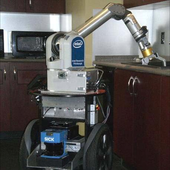Highlight
Algorithms for a Home Robot
Achievement/Results
NSF-funded researchers at Carnegie Mellon University (James Kuffner), the University of Pittsburgh (Rory Cooper), and Intel Research Pittsburgh (Siddhartha Srinivasa) are collaborating to create a prototype home robot and real-life-ready planning and perception algorithms. The NSF-funded Interdisciplinary Research Training Opportunities Program (IGERT) in Assistive Technology at CMU and the University of Pittsburgh focuses on developing ways to help people with disabilities and older adults. Home robots is one way to provide assistance to people with motor disabilities, and help older adults live in their own homes as long as possible. Our discussions with potential users revealed the need for manipulation of relatively lightweight objects: getting objects; opening wrapped packages and boxes; preparing meals; and doing household chores. However, the typical home environment is complex, cluttered, and hard to perceive.
The robot that has been developed uses learned models of objects to enable itself to see. To do real tasks, the robot must plan how to reach and grasp objects, and move them in a cluttered environment. IGERT Fellow Dmitry Berenson implemented and tested the Constrained Bi-directional Rapidly Exploring Random Tree motion planning algorithm. This algorithm enables a robot to grasp objects in cluttered environments. He has found ways to coordinate reaching with grasping. His framework for handling constraints allows his algorithms to plan for manipulation tasks that were previously unachievable in the general case, such as sliding and lifting heavy objects. He also developed ways to simplify interfaces for home robots.
Address Goals
The algorithms that have been developed advance the state of the art in robotics.
The robot that has been developed can be replicated to enable this type of research at many sites.







